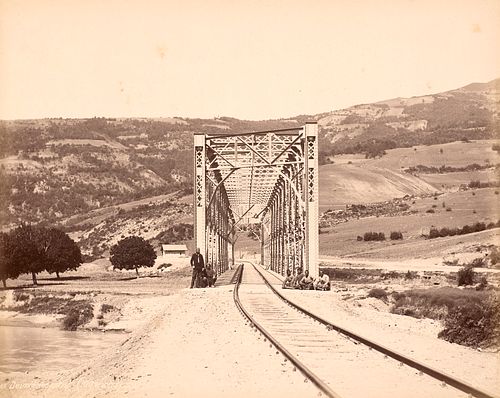Chemin de fer d'Anatolie. Mappe mit 40 großformatigen Photographien (davon 3 Panoramen) des ersten Streckenabschnittes von Istambul nach Bilecik, der
Lot 918
Absentee vs Live bid
Two ways to bid:
- Leave a max absentee bid and the platform will bid on your behalf up to your maximum bid during the live auction.
- Bid live during the auction and your bids will be submitted real-time to the auctioneer.
Bid Increments
| Price | Bid Increment |
|---|---|
| EUR€0 | EUR€10 |
| EUR€100 | EUR€10 |
| EUR€200 | EUR€20 |
| EUR€300 | EUR€30 |
| EUR€420 | EUR€30 |
| EUR€480 | EUR€20 |
| EUR€500 | EUR€50 |
| EUR€2,000 | EUR€200 |
| EUR€3,200 | EUR€300 |
About Auction
By Jeschke Jádi Auctions Berlin GmbH
Apr 29, 2022
Set Reminder
2022-04-29 07:00:00
2022-04-29 07:00:00
America/New_York
Bidsquare
Bidsquare : Rare Books, Prints, Classical Art (Auction 141)
https://www.bidsquare.com/auctions/jeschke-van-vliet/rare-books-prints-classical-art-auction-141-9237
Jeschke Jádi Auctions Berlin GmbH info@jvv-berlin.de
Jeschke Jádi Auctions Berlin GmbH info@jvv-berlin.de
- Lot Description
Türkei - Eisenbahn Chemin de fer d'Anatolie. Mappe mit 40 großformatigen Photographien (davon 3 Panoramen) des ersten Streckenabschnittes von Istambul nach Bilecik, der als Bagdadbahn bekannt gewordenen Strecke Istanbul nach Ankara. (Istanbul Selbstverlag, um 1890.) Gr.-Folio (41,5 x 35 cm), 40 Photographien (26 x 21 cm), je mit einbelichtetem Titel und Signatur, aufgewalzt auf starkem Karton, mit ornamentalem Rahmen und arabischer Titelbezeichnung versehen, rote gold- und blindgepr. Halbledermappe mit 3 erneuerten Bindebändern. Sehr selten. Die Pierre de Gigord collection of photographs of the Ottoman Empire and the Republic of Turkey in der Getty Library verzeichnet unter den Signatur 96.R.14(A20) ein identisches Album aber mit nur 12 großformatigen Photographien. - Prachtvolles Album des ersten Bauabschnittes der Anatolischen Eisenbahn von Istanbul bis auf die Höhe von Bilecik und endet mit dem Bau der Pekdemir-Brücke bei KM 234. Die Photographien zeigen Aufnahmen der Strecke, Streckenbauwerke (Brücken, Tunnel, Bahnstationen), Ortsansichten, Alltags- und Straßenszenen, sowie Monumente der Region an der Bahnlinie. Die drei, aus mehreren Fotos zusammengesetzten Panoramen zeigen 2 Ansichten von Bilecik und 1 Ansicht von Isnik (Nikaia). Der Photograph Berggren (1835, Stockholm - 1920, Istanbul) wurde durch seine Panoramen, Portraits und Alltagsszenen bekannt. Von herausragender, historischer Bedeutung waren seine Dokumentationen. Hierunter fällt auch die den Bau der Anatolischen Eisenbahn begleitende Streckendokumentation, welche heute zu den wenigen Zeugnissen der frühen osmanischen Eisenbahngeschichte zählt, in der das Deutsche Reich eine bedeutende Rolle spielte. Die Anatolische Eisenbahn wurde durch die SCFOA - Societe du Chemin de Fer Ottoman d'Anatolie - betrieben. Die Gründung der Gesellschaft und ihre Finanzierung erfolgten unter deutscher Führung (Deutsche Bank) und mit deutschen Mitteln. Die Materialien für den Streckenbau wurden komplett aus Deutschland geliefert. Der Bau selbst erfolgte durch die Frankfurter Firma Philipp Holzmann, Schienen lieferte der Stahlkonzern Friedrich Krupp AG und selbst die technische Ausstattung erfolgte mittels deutscher Firma wie Kraus & Comp., J. A. Maffei, Henschel, Borsig, Cail, Maschinenfabrik Esslingen u. a. - Mappe unter Verwendung der originalen Materialien, kaum merklich, fachmännisch restauriert. Die Abzüge in nahezu perfektem, sauberem Zustand. Karton gering gebräunt, sehr vereinzelt im Rand etwas angestaubt bzw. minimalst braunfleckig. Sehr gutes Exemplar der Dokumentation dieses deutsch-osmanischen Gemeinschaftsprojektes der Kaiserzeit. - Sehr seltene Dokumentation von herausragender Qualität. Turkey. - Railway. - Magnificient Album with 40 large-format photographs (including 3 panoramas) of the first section of the line from Istambul to Bilecik, the Istanbul to Ankara line known as the Baghdad Railway. (Istanbul self-published, c. 1890.) Large folio (41.5 x 35 cm), 40 photographs (26 x 21 cm), each with inset title and signature, rolled on strong cardboard, decorated with ornamental frame and Arabic title inscription, red gilt and blind-stamped half-leather portfolio with 3 renewed binding bands. Very rare. The Pierre de Gigord collection of photographs of the Ottoman Empire and the Republic of Turkey in the Getty Library lists an identical album under the shelfmark 96.R.14(A20) but with only 12 large format photographs. - Splendid album of the first construction phase of the Anatolian Railway from Istanbul to the height of Bilecik and ending with the construction of the Pekdemir Bridge at KM 234. The photographs show shots of the line, line structures (bridges, tunnels, railroad stations), village views, everyday and street scenes, as well as monuments of the region along the railroad line. The three panoramas, composed of several photographs, show 2 views of Bilecik and 1 view of Isnik (Nikaia). The photographer Berggren (1835, Stockholm - 1920, Istanbul) became famous for his panoramas, portraits and everyday scenes. Of outstanding, historical importance were his documentations. Among them is the documentation of the construction of the Anatolian Railway, which today is one of the few testimonies of the early Ottoman railroad history, in which the German Empire played an important role. The Anatolian Railway was operated by the SCFOA - Societe du Chemin de Fer Ottoman d'Anatolie. The company was founded and financed under German leadership (Deutsche Bank) and with German funds. The materials for the construction of the line were supplied entirely from Germany. The construction itself was done by the Frankfurt company Philipp Holzmann, rails were supplied by the steel company Friedrich Krupp AG and even the technical equipment was done by means of German companies such as Kraus & Comp., J. A. Maffei, Henschel, Borsig, Cail, Maschinenfabrik Esslingen and others - portfolio expertly restored using the original materials, barely noticeable. Prints in near perfect, clean condition. Cardboard slightly browned, very occasionally in the margin a little dusty or minimally brown-stained. Very good copy of the documentation of this German-Ottoman joint project of the imperial period. - Very rare documentation of outstanding quality.
- Buyer's Premium



 EUR
EUR CAD
CAD AUD
AUD GBP
GBP MXN
MXN HKD
HKD CNY
CNY MYR
MYR SEK
SEK SGD
SGD CHF
CHF THB
THB







